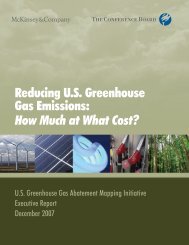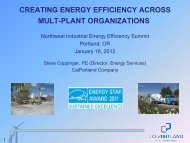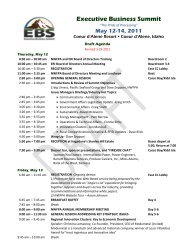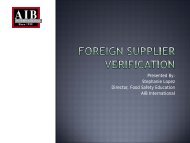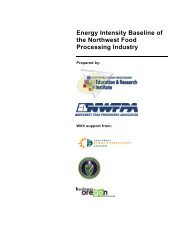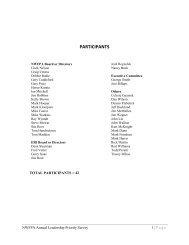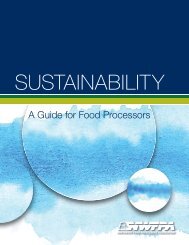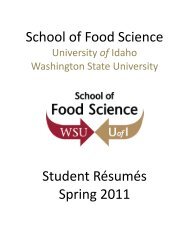Download
Download
Download
Create successful ePaper yourself
Turn your PDF publications into a flip-book with our unique Google optimized e-Paper software.
Creating Energy Efficiency<br />
Across<br />
Multi –Plant Organizations<br />
Mike Henderson, PE, CEM<br />
Energy and Environmental Engineering Manager<br />
ConAgra Foods Lamb Weston, Inc<br />
Kennewick, Washington.
ConAgra Foods Lamb Weston Scope<br />
• 13 major North American plants<br />
• WA, OR, ID, LA, MN, AB<br />
• Over 15 Utilities<br />
• Primarily frozen potato products<br />
• Over 4.5B lb/yr<br />
• Over 6000 people<br />
• Over 50M$/yr energy spend
ConAgra Foods Lamb Weston Scope<br />
• Typically 24/7 approaching 300 D/yr Op<br />
• In this business, primary cost drivers:<br />
– raw product<br />
– labor<br />
– fuel, power, water<br />
• Around 15% of total<br />
• Significant cost, but not the primary driver<br />
• With Energy Efficiency, we must compete for<br />
“SHARE OF MIND”
Corporate Energy Structure<br />
• Large decentralized technical support<br />
• Facility Engineering technical staff<br />
– Plant Engineering Manager<br />
– Plant industrial Engineer<br />
– Plant Maintenance supervisors<br />
– Typically shared Energy and<br />
Environmental Manager
• Corporate<br />
Corporate Energy Structure<br />
– Energy and Environmental Engineering<br />
Manager<br />
– 2 Corporate Sr. Engineers focused on<br />
energy<br />
– Other engineers as project loads demand<br />
– Energy often integrated into other projects<br />
– Building relationships with plant teams is a<br />
critical function
Corporate Energy Structure<br />
• Goal is to empower and support plants<br />
• Help is defined by the one who<br />
receives it!
Corporate Continuous Improvement<br />
Structure<br />
• CI Corporate support is substantial:<br />
– 2 CI Directors<br />
– 8 Managers<br />
• CI Plant internal teams:<br />
– Led by high level CI Manager with critical<br />
line direct reports
Corporate Continuous Improvement<br />
• CI Teams<br />
– Regular meetings<br />
Structure<br />
– Employee suggestion “T” cards<br />
• All areas of improvement, including energy and<br />
other sustainability<br />
– Systematic follow up<br />
– Up-feed to the Capital Program
Execution<br />
• Capital is a major mechanism of<br />
achieving savings<br />
• Ideas from all inputs<br />
– CI groups<br />
– Facility analysis<br />
– Retro-commissioning<br />
– Replication, where it fits
Execution<br />
• Capital Planning cycles<br />
– Built on CAG LW Fiscal Years (June to<br />
May)<br />
– Long term strategic plan<br />
– 3 year plan (earlier years are the best<br />
developed)<br />
– Current year (highly developed, ready to<br />
execute on final approval)
Measurement<br />
• Corporate Sustainability Goal of 20%<br />
GHG reduction by end of 2015<br />
• Divided to all facilities<br />
• Monitored, tracked<br />
• Depends upon ability to identify and<br />
execute economic projects<br />
• Current low natural gas prices adding<br />
challenge!
What’s Working Well<br />
• Project identification and execution<br />
• Electricity Incentives have focused<br />
capital<br />
• Electricity incentive staff funding has<br />
greatly assisted project identification<br />
and completion<br />
• Over 25,000,000 kwh/yr savings<br />
accomplished
What’s Working Well<br />
• Focused retro-commissioning, aka<br />
“Track and Tune”, “Kaizen Blitz”<br />
• Specifically, the BPA Energy Smart<br />
Industrial (ESI) program is an example<br />
of excellent conservation achievement<br />
• Excellent training resources through our<br />
Utilities, typically with support from<br />
NEAA, BPA, DOE, WSU Energy office
Areas of Opportunity<br />
• Ferret out synergies with the greater<br />
cost impact areas (raw input and labor)<br />
– More process understanding “Know<br />
thyself!”<br />
• Advocate to continue electricity<br />
conservation incentives, with<br />
conservation priced at the utility<br />
marginal resource and cost treated as<br />
new generation
Areas of Opportunity<br />
• More systematic replication of projects<br />
and best practices across all applicable<br />
facilities (overcome facility differences)<br />
• Determine better ways to utilize<br />
available resources and assistance<br />
• Continue to provide senior leadership<br />
with sustainable, economic energy<br />
choices



